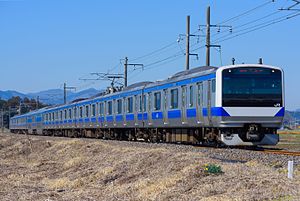E531 series
| E531 series | |
|---|---|

A 10-car E531 series train on the Joban Line in March 2016
|
|
| In service | 2005–Present |
| Manufacturer | Tokyu Car Corporation, Kawasaki Heavy Industries, JR East, J-TREC |
| Replaced | 403 series, 415 series |
| Constructed | 2005–2014 |
| Number built | 335 vehicles (23 10-car sets, 21 5-car sets) |
| Number in service | 325 vehicles |
| Formation | 5/10 cars per trainset |
| Operator(s) | JR East |
| Depot(s) | Katsuta |
| Line(s) served | Ueno-Tokyo Line, Jōban Line, Mito Line |
| Specifications | |
| Car body construction | Stainless steel |
| Car length | 20,000 mm (65 ft 7 in) |
| Width | 2,950 mm (9 ft 8 in) |
| Floor height | 1,130 mm (3 ft 8 in) |
| Doors | 4 pairs per side |
| Maximum speed | 130 km/h (80 mph) |
| Acceleration | 2.5 km/h/s |
| Deceleration | 4.2 km/h/s |
| Electric system(s) | 1,500 V DC & 20 kV AC (50Hz) |
| Current collection method | PS37A single-arm pantograph |
| Bogies | DT71 (motored) TR255 (trailer) |
| Braking system(s) | Regenerative brake |
| Safety system(s) | ATS-SN, ATS-P, ATS-Ps |
| Track gauge | 1,067 mm (3 ft 6 in) |
The E531 series (E531系?) is an electric multiple unit (EMU) train type operated by East Japan Railway Company (JR East) in Japan. It was introduced by JR East on 9 July 2005 to replace the aging 403 and 415 series EMUs running on the Jōban Line from Ueno Station in Tokyo. The stock is a dual-voltage (1,500 V DC & 20 kV AC) development of the DC-only E231 series suburban EMU design, and can run at speeds of up to 130 km/h (80 mph) in service.
Trains are formed in 10-car (set numbers K-401 onward) and 5-car (set numbers K-451 onward) sets. 15-car formations are generally run between Ueno and Tsuchiura. 10- and 5-car sets operate singly north of Tsuchiura, and 5-car sets are used on the Mito Line.
The E531 series sets are formed as shown below with car 1 (11) at the Ueno end. All sets are based at Katsuta Depot.
Sets K401–423 (23 sets):
Cars 3 and 8 have one single-arm pantograph each. Cars 1, 5, and 10 have toilets (universal access in cars 1 and 10). Car 9 is numbered in the SaHa E531-2000 series for sets K412 to 422 (cars originally used as cars 4 and 5 in sets K401 to 421).
Sets K451–469 (19 sets):
Car 13 has one single-arm pantograph. Car 11 has a toilet (universal access).
Sets K551–:
The original 10-car sets delivered without bilevel Green cars were formed as follows.
Cars 3 and 8 had one single-arm pantograph each. Cars 1 and 10 had toilets (universal access).
Cars 3 and 8 had one single-arm pantograph each. Cars 1 and 10 had toilets (universal access).
An ordinary-class car with longitudinal seating
An ordinary-class car with a mixture of longitudinal and transverse seating
...
Wikipedia
